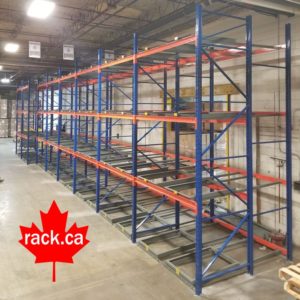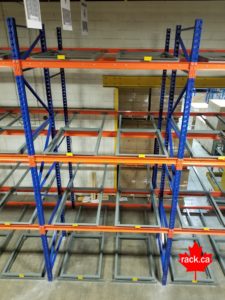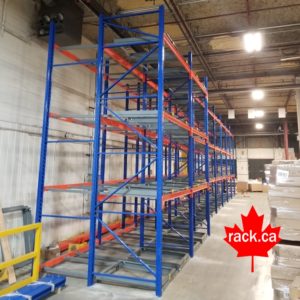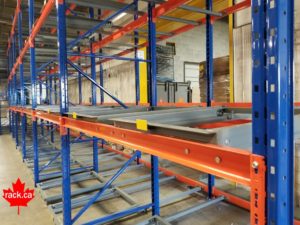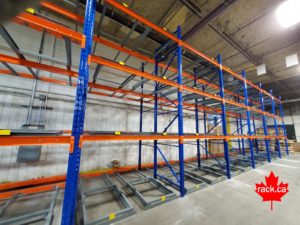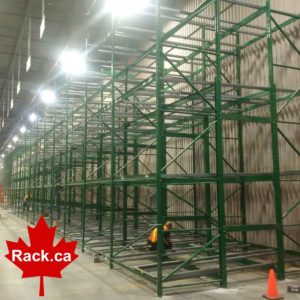You’ve probably heard of or seen pushback pallet rack systems a number of times. Even if you don’t work in the warehousing industry, pushback racking systems are often used in various industries.
They contain mechanisms that hold products securely in place with a rail and cart type system installed into structural and roll form pallet racking systems. Products at the front of the line are typically removed first as those are the closest to expiry or their best before dates whereas products toward the back of the line have more time. When a product is removed from the front of the rack, the one that was behind will automatically roll forward as the product in front is removed. If a product is placed back on the shelf, then the rest of the products are pushed back to make space. This is often referred to as the “first in, last out” model or FILO.
In a warehouse environment, pushback pallet rack systems are also widely used to store products that have large amounts of multiple SKUs because they provide a top-notch organizational system. Capable of storing multiple pallet types of various shapes and sizes, pushback pallet racks are incredibly safe and versatile for any warehouse and distribution center setting. As long as certain safety standards and guidelines are consistently met and practiced, push-back pallet racks are a great choice for facilities throughout the GTA.
Here are some important safety guidelines to adhere to when incorporating a pushback pallet rack system into your facility infrastructure.
Keep Your Loading Safe and Consistent
A well-organized warehouse should operate like a well-oiled machine. Regardless of what type of pallet rack system you have or are installing in your warehouse, it’s important to establish strict and easy-to-follow safety guidelines. The next step is to carefully train your entire staff of forklift operators and warehouse workers on how to work around and with the new pallet racking system. Pushback pallet racks are no different.
Practice Safe Loading Techniques
Certain push back pallet racks are designed to carry specific types of pallets. Make sure that your pushback pallet rack system is compatible with the size, shape, and weight of the pallets that you plan to store on it. Otherwise, you could negatively impact the performance of the rack, weaken its structural integrity over time, and cause it to collapse or buckle under the weight. Avoid storing pallets that are too heavy for the weight capacity of your pushback pallet rack system. If you’re having a hard time placing a pallet on top of the storage unit, then that pallet and racking system are incompatible. Never apply additional force to get a pallet to fit on the racking system, as this can cause serious damages and potential safety risks. NEVER use broken pallets as debris from the pallets may interfere with the push back tracks and the movement of the pushback carts.
Confirm the Structural Alignment
When placing a pallet onto the pushback lane, it’s important to ensure that the fork truck is perfectly aligned with the opening of the lane. While inserting the pallet into the system, the forklift operator should lift it approximately three to four inches above the top cart and tilt the forks upward to align them properly with the rail.
Once the pallet is placed squarely inside the pushback racking lane, the forklift operator should confirm that the pallet and lane are in perfect alignment before removing the forks. Structural alignment is important because it ensures even weight distribution throughout the racking system and prevents undue weight and pressure from being placed on a single component, which can cause strain.
Load the Pallets Carefully and Slowly
Warehouse employees such as forklift drivers should be trained on the correct way of loading and unloading pallet racks from a pushback system. Start by designating a loading and unloading aisle, so that warehouse workers know which side of the pallet is for loading and unloading. This will eliminate a great deal of confusion and backlog while also emphasizing safety standards.
To safely unload pallets from a pushback system, the forklift needs to be perfectly aligned with the face of the rack. Tilting the forks at a slight upward angle will ensure that they fit in perfectly with the upward slope of the system. The forklift operator can then lift the pallet a few inches off of the lane until there’s enough clearance and then slowly back out of the opening. The forklift operator should pay close attention to their speed and back out of the aisle slowly to maintain better control over the maneuver.
Don’t Push Against Resistance
If you feel any resistance while attempting to load or unload a pallet, stop the process immediately. The cause of the resistance should be investigated to the full degree to prevent potential damage and injury from occurring. Resistance can be caused by many problems such as debris in the tracks, a broken bearing, a misaligned or improperly installed pallet racking system. This can also cause a pallet to get stuck on another cart or bump against the uprights next to the lane. Pushing against resistance or forcing a pallet in or out could cause damage to pallets and loads, damage the wheels / bearings on the carts, cause the rails in the pushback lane to warp and twist or become seriously damaged. With a good preventive maintenance program in place it should help to prevent all the mentioned potential issues above.
Designate Load-In and Load-Out Aisles
Your warehouse should have clearly marked load-in and load-out aisles, so that forklift operators can distinguish between the two. Directional markers such as arrows on the ground should also be used to indicate the direction of the path for each aisle. Some aisles are wide enough to have two directional markers running in opposite directions, while others are too narrow and only have space for one-way travel. Differentiating between the two ensures that forklift operators have enough room to maneuver their machines without any incident or getting in each other’s way.
Aisles that are currently in use should be blocked off with safety gates, so that other warehouse workers know not to go down those aisles until the work is complete.
High-Quality Storage Racks in Toronto, Ontario
Canadian Rack Technologies Inc. is one of the leading suppliers of pushback pallet racking systems in Toronto, Mississauga, and the rest of the GTA. Our team of skilled engineers provide detailed facility assessments, so that we can make educated and well-thought out customized pallet rack storage solution recommendations for your facility. Contact us today to learn more about our services.
